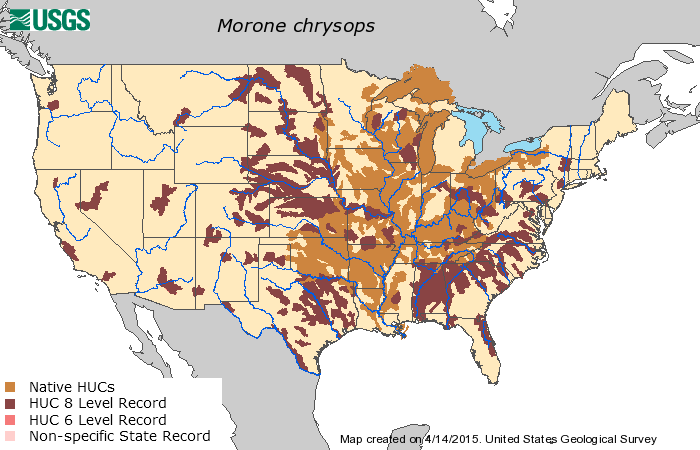White Bass

Scientific Name: Morone chrysops
Common Names: White Bass, Sand Bass, Silver Bass
White Bass range in color from a silvery white to a pale green. Their backs are mostly black, while their sides and belly are pale with stripes running along them. They have large, rough scales and two dorsal fins. The one near the tail appears to have spines and is much harder than the other, which sits near the head.
White Bass are known to grow to a length between 10 and 12 inches and weigh an average of 1 pound. Both of those figures are what is typical, but record-sized members of the fish species have been found to reach 17 inches and weigh more than 6 pounds.
As for White Bass behavior, the fish tend to avoid eating aquatic plants and focus on finding other organisms to eat. Popular prey creatures for them include zooplankton, small crustaceans, minnows, bait fish and water fleas. White Bass inhabit mostly rivers, creeks and streams, but can be found spawning in medium and large lakes, as well as manmade reservoirs.
White Bass reproduce between March and May each year in waters that range from 54 to 68 degrees Fahrenheit. They prefer to lay their eggs in moving streams but will also spawn in nearshore lake currents that get swept up by winds. Female White Bass can lay as many as a half million eggs.
White Bass Interesting Facts
- The state record in Florida for largest White Bass ever caught weighed 4.69 pounds;
- White Bass are related to Striped Bass, which has led some to call them “wipers”;
- huge schools of White Bass have been known to herd groups of baitfish toward the surface as they go into feeding frenzies;
- White Bass have a sharp point on each gill cover, while Striped Bass have two;
- and White Bass are the fifth most preferred species among licensed Texas anglers, according to the state’s parks and wildlife foundation.
White Bass Distribution
The native range of White Bass stretches north into the Canadian provinces of Quebec and Manitoba and reaches southward limits in the U.S. state of Louisiana. It can be found in New Mexico, Texas and the Gulf Coast states by way of the Mississippi River.

A map showing the distribution of White Bass across the continental United States. (Credit: U.S. Geological Survey)
White Bass Biology
An investigation published in 2011 in the Journal of Great Lakes Research found that Lake Erie White Bass populations are not likely to be genetically distinct. Scientists used naturally occurring differences in otolith bones to make the find and also noticed a pattern showing decreased natal homing behavior by White Bass as their ages went up.
In 1997, researchers at the University of Maryland exposed captive white bass to increased water temperatures and a drug designed to make them release reproductive hormones. They found that the treatment increased the amount of fish milt expressed by the fish under study. Full results are published in the journal Aquaculture.
A 2013 study investigating the effects of underwater pile driving sounds on the health of hair cells in fish ears found that fish like Tilapia and hybrid Striped Bass, a fish that is half White Bass, experienced more trauma to swim bladders and surrounding organs than their ears when subjected to high-decibel noises. The bass appeared to be more affected by the sounds than other fish in the study, as researchers uncovered significant numbers of damaged hair cells in their ears.
References Cited
- http://nas.er.usgs.gov/queries/factsheet.aspx?SpeciesID=779
- https://www.seagrant.wisc.edu/fish-id/#fishMain
- https://www.dnr.state.mn.us/invasives/aquaticanimals/whiteperch/index.html
- https://www.dnr.state.mn.us/fish/whitebass/index.html
- http://tpwd.texas.gov/huntwild/wild/species/wtb/
- http://wildlife.ohiodnr.gov/fishing/fishing-tips-by-species/white-bass#tabr5
- http://www.michigan.gov/dnr/0,4570,7-153-10364_53405-216555–,00.html
- https://myfwc.com/wildlifehabitats/profiles/freshwater/white-bass/
- http://www.sciencedirect.com/science/article/pii/S109564331300189X
- http://www.sciencedirect.com/science/article/pii/S0380133011002048
- http://www.sciencedirect.com/science/article/pii/S0044848697000215
White Bass article by Daniel Kelly, Fondriest Environmental, April 2015










[…] For a great illustration of white bass, check out this US Fish & Wildlife Service page. To get an more in-depth bio of the white bass check out Lake Scientist. […]
[…] White bass has many other common names, including sand bass and silver bass. This particular species is an open water fish. Therefore, they gather in large reservoirs, rivers, creeks, lakes, and ponds. Learn interesting facts about white bass here. […]